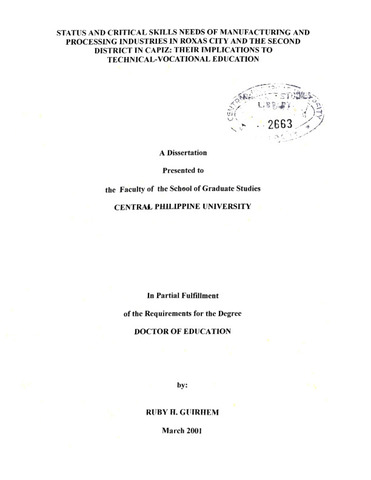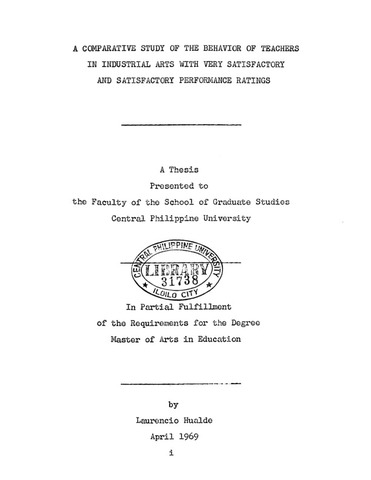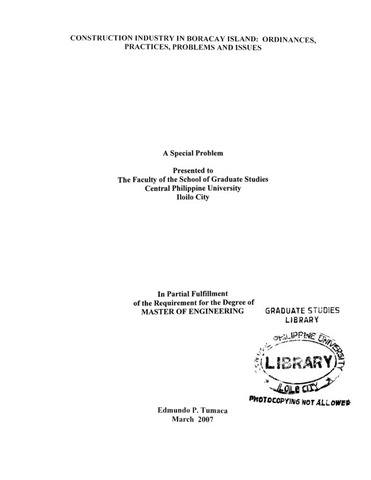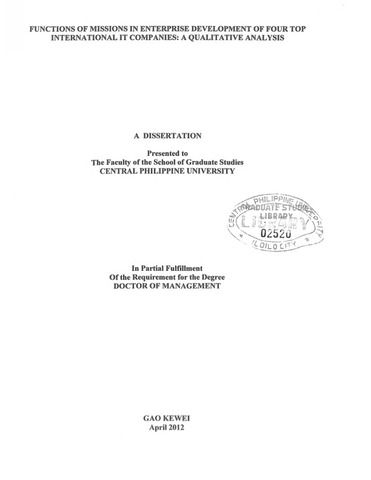Status and critical skills needs of manufacturing and processing industries in Roxas City and the second district in Capiz: Their implications to technical-vocational education
Résumé
The study was conducted to determine the characteristics and critical skills needs of manufacturing and processing industries in Roxas City and the second district of Capiz and the variations in the critical skills needs in terms of selected characteristics of these industries. The study further aimed to determine the workers’ personal and work related characteristics and the association between their characteristics and their wage. The study also aimed' to determine the extent to which the needs are met and the industries’ plans for expansion.
This is a descriptive-relational study which utilized the survey method. Data were collected through personal interview with owners and 123 workers of 54 manufacturing and processing industries in Roxas City and the second district in Capiz. The data were processed and analyzed using the statistical package of Social Sciences (SPSS+1) version 7 for Windows.
Major Findings of the Study
Profile of the Industries
Most of the manufacturing and processing industries in Roxas City and the second district in Capiz were found within the geographical confines of the city of Roxas. The industries were classified into: garments, food processing, handicraft, metal/iron works, concrete products, furniture, electronics and other industries (rice mill, ice plant, lime manufacturing). A great majority (77.0 percent) of the industries was small scale with total capitalization of less than P500,000.00 and had one to five workers only. Nearly half of the industries have been operating for 10 years. Most of the industries were owned by single proprietors. They recruited their workers through recommendations and referrals, and employed interview in hiring their workers. Most of the industries had no link with a training institution. Most of the industries have increased capitalization since their last operation and size of work force.
Skills Needs/Requirements of the Industries
Thirteen of industries expressed need for additional skilled workers. The needs of food processing industries were mostly bakers, packers, kaong maker, sorters and nonsorters. The garment industries need mainly sewers. Two furniture industries out of 7 need carvers, furniture and cabinet maker/furniture and cabinet maker/furnishers, sash maker and turner while also two handicraft industries out of four need a lifter, operator and dispatcher.
Most of the industries had no plans to expand their business establishments. Their most common problems were lack of capital/machinery and credit collection, and difficulty to cope with demand of their product because of manpower shortage.
Most of the industries had not conducted any skills training for their workers. Training conducted of those who did as the need arose were mostly in-house in nature.
Profile of the Production Workers
Most of the production workers were 30-39 years old, female, secondary/high school graduates, have been in service for 5 years or less and had a monthly income of P3001 to 4000. The majority (60.2 percent) of the workers enjoyed SSS/Medicare.
Almost three fourths of the workers have not attended or undergone skills training. The common skills possessed by the workers and those skills they acquired at work were cooking, baking, furniture and cabinet making/finishing, carpenter, carving and turner. Twenty-seven percent of the total workers were working as baker, steamer, chicharon maker, slicer, marketer and longganisa/tocino maker and 16.2 percent did electronics skills.
The majority of the workers have mismatched educational background and job function as well as skills possessed and job functions. This means that many of them are involved in jobs for which they were not educationally prepared to do. Most of them acquired their skills when they were already working in the industry.
Relational Analysis Between Skills Needs of Industry and Selected Industry Characteristics
The skills needs of the industries were not significantly associated with most of the characteristics of the industries. Only the specific type of industry and linkage with training institutions were found to be significantly associated with skills needs. Skills needs were found to be higher among handicraft and garment industries. Industries with linkage with training institutions had more skill needs than those who did not have linkage.
The geographical location, type of industry, size of industry in terms of initial and current capitalization, size of workforce, length of operation, type of ownership and recruitment and hiring practices had no influence on the skills needs.
Relational Analysis Between Selected Personal and Work-related Characteristics and Wage
There was a significant relationship between each of the workers’ characteristics, such as their sex, age, educational attainment, length of experience, attendance in skills training, and skills possessed and wage. Female workers received better pay than the male workers. Workers in their 30s and those with more than five years of work experiences also received better pay that those who were younger or older and those who were new in the establishments, respectively. Those who were elementary graduates only earned significantly less than those with better education.
Workers with job functions congruent with their educational preparation and skills possessed also received better pay than those whose educational background and skills did riot match their job needs. Moreover, workers who had attended skills training during the time they were already working had higher wages than those who did not attend any training at all. The skilled workers also received better pay than the unskilled ones.
Conclusions
Based on the findings, the following conclusions were formulated:
1. The skills needs of industries and specific type of industry and linkage with training institution showed that the hypothesis “that the skills needs of industries are influenced by specific type of industry and linkage is accepted. In this study, the skills needs of industries is higher among handicraft and garment industries.
2. The skills needs of the industries did not significantly vary according to the industries’ location, type and size, size of workforce, length of operation, type of ownership, and recruitment and hiring practices. Skills needs of industries, therefore, is not influenced by their location, type and size, size of workforce, length of operation, type of ownership, recruitment and hiring practices is rejected.
3. There is a significant relationship between sex and wage of workers. Female workers received better wages than their male counterparts.
4. There is a significant relationship between age of workers and their wage. Wage increased as the workers grew older.
5. There is a significant relationship between the worker’s educational attainment and their wage. The higher the educational attainment of the workers, the higher would also be their wage.
6. There is a significant relationship between the length of service and the workers’ wage. Workers who have stayed in service for quite a number of years, the higher wage they would receive.
7. There is a significant relationship between skills possessed and present job of workers. Workers who possessed skills that matched their work tended to receive higher wages than those whose skills did not match their educational attainment.
8. There is a significant relationship between the worker’s attendance in skills training during their work in the industry and wage. Trained workers tended to have better outputs and better wage than those who did not undergo training.
9. There is a significant relationship between the workers’ skills and wage. Skilled workers tended to have higher wages than those who were unskilled.
Recommendations
Based on the following conclusions of the study, the following are recommended:
1. A strong linkage between educational institutions and industries must be established.
2. Technical-vocational schools through their administrators should periodically revise or change their curriculum in consultation with industries.
3. Technical vocational schools should regularly conduct skills training in collaboration with the industry before/after the entry of their graduate to the industries to further enhance their skills competency.
4. Dual System/Training or on the job training of graduates must be strengthened to provide graduates/trainees in school the theoretical foundation, basic training, guidance and human formation as well as developing their skills and proficiency in actual work condition.
5. Technical-vocational schools should conduct seminars, workshops to teachers to enhance their teaching competencies so that they can also improve the quality of technical-vocational graduates.
6. A well-planned, systematic and structured recruitment and hiring practices of the industry must be adopted to ensure matched work and skills of its workers.
7. In order to improve wages and benefits of workers, there should be a regulatory body that should formulate compensation guidelines and to make sure that these guidelines are implemented properly.
8. Further study on the manufacturing and processing industries should be conducted on a wider scale and in a different setting to explore other critical skills needs of the existing industries. Additional factors or variables must also be studied in relation to the status and performance of the different types of industries.
Description
Abstract only
Suggested Citation
Guirhem, R. H. (2001). Status and critical skills needs of manufacturing and processing industries in Roxas City and the second district in Capiz: Their implications to technical-vocational education (Unpublished Doctoral dissertation). Central Philippine University, Jaro, Iloilo City.
Type
DissertationSujet
Department
School of Graduate StudiesDegree
Doctor of Education major in Educational Administration and SupervisionShelf Location
GSL Theses 378.242 G949
Physical Description
xviii, 146 leaves
Related items
Showing items related by title, author, creator and subject.
-
A comparative study of the behavior of teachers in industrial arts with very satisfactory and satisfactory performance ratings
Hualde, Laurencio (1969)The purpose of this study was to investigate the teaching behaviors of the good and the poor teachers in industrial arts. The teachers with the highest performance ratings from thirty to thirty-five points were considered ... -
Construction industry in Boracay Island: Ordinances, practices, problems and issues
Tumaca, Edmundo P. (2007)To examine the construction business in Boracay Island in terms of Local Ordinances if they conform to the National Building Code (NBC) and National Structural Code of the Philippines (NSCP), the documents containing local ... -
Functions of missions in enterprise development of four top international IT companies: A qualitative analysis
Kewei, Gao (2012)Humans are born with life. Once a person is born, he can live. As long as he is provided with the basic survival conditions, he will have the ability of self-sustaining, and he can live on. The enterprise is not a life ...





